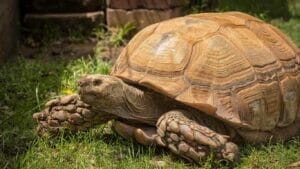
Not a lot is known about the habits of wild African Spurred Tortoises due to a lack of field research. They are known for being solitary animals that spend most of their lives living below ground in some of the harshest environments in Africa. Tortoises come from an incredibly old group of reptiles that date back around 220 million years. Because of the time they've had to evolve, they're well adapted to their incredibly unforgiving environments.
Appearance
The African Spurred Tortoise is the third-largest tortoise species in the world, and the largest mainland species. They’re so large, in fact, that they have been recorded at over 230 pounds! It’s not uncommon to find these animals being sold as pets, however, their fast growth rate and specific needs can make them hard to manage as adults. The African Spurred Tortoise’s shell is a part of its skeleton, permanently attached to the spine and rib cage. Tortoises can feel pressure and pain through their shells, similarly to how you can feel pressure through your fingernails.
Adaptations
To protect themselves from extreme temperatures in the desert and savannas, African Spurred Tortoises are excellent diggers, and will often build elaborate tunnel systems with dens that can reach up to 10 feet into the earth! They don’t usually drink water; instead, tortoises rely on soaking themselves in water in order to hydrate. They are curious, and often very interested in interacting with the world around them, especially when they’re young.
Turtle or Tortoise?
This question has been around for as long as turtles and tortoises have been (so, millions of years). The answer is relatively simple: tortoises are generally recognized as land-dwelling, with round, stubby feet made for digging and a heavy, domed shell. Turtles, on the other hand, are aquatic or semi-aquatic creatures that tend to have flatter, more webbed feet and sleeker shells to glide through water.
Where are they?
You can visit the African spurred tortoise at Animal Discoveries.
VIEWING TIPS
As a reptile, the best time to visit the tortoise is on days with a pleasant temperature.
Quick Facts
Scientific Name | Geochelone sulcata |
Species Survival Plan | No |
Habitat | Hot, arid environments; desert fringes to dry savannahs |
Food | Grass, plants, flowers, some insects and grubs |
Originally Native To | Southern Sahara desert including the countries of Chad, Sudan and Ethiopia |
Characteristics | Third-largest land tortoise; broad, oval, flattened carapaces that are brown to yellow in color; legs are covered in spurs |
Lifespan | Unknown in the wild. |
Social Behavior | Solitary, only meet up to breed |




